Welcome to Matrix Education
To ensure we are showing you the most relevant content, please select your location below.
Select a year to see courses
Learn online or on-campus during the term or school holidays
Learn online or on-campus during the term or school holidays
Learn online or on-campus during the term or school holidays
Learn online or on-campus during the term or school holidays
Learn online or on-campus during the term or school holidays
Learn online or on-campus during the term or school holidays
Learn online or on-campus during the term or school holidays
Get HSC exam ready in just a week
Select a year to see available courses
Science guides to help you get ahead
Science guides to help you get ahead

Guide Chapters
You, like many students, might feel that textual analysis sounds ominously overwhelming, broad, and vague. But it shouldn’t be. There is a process for reading and analysing your English texts.
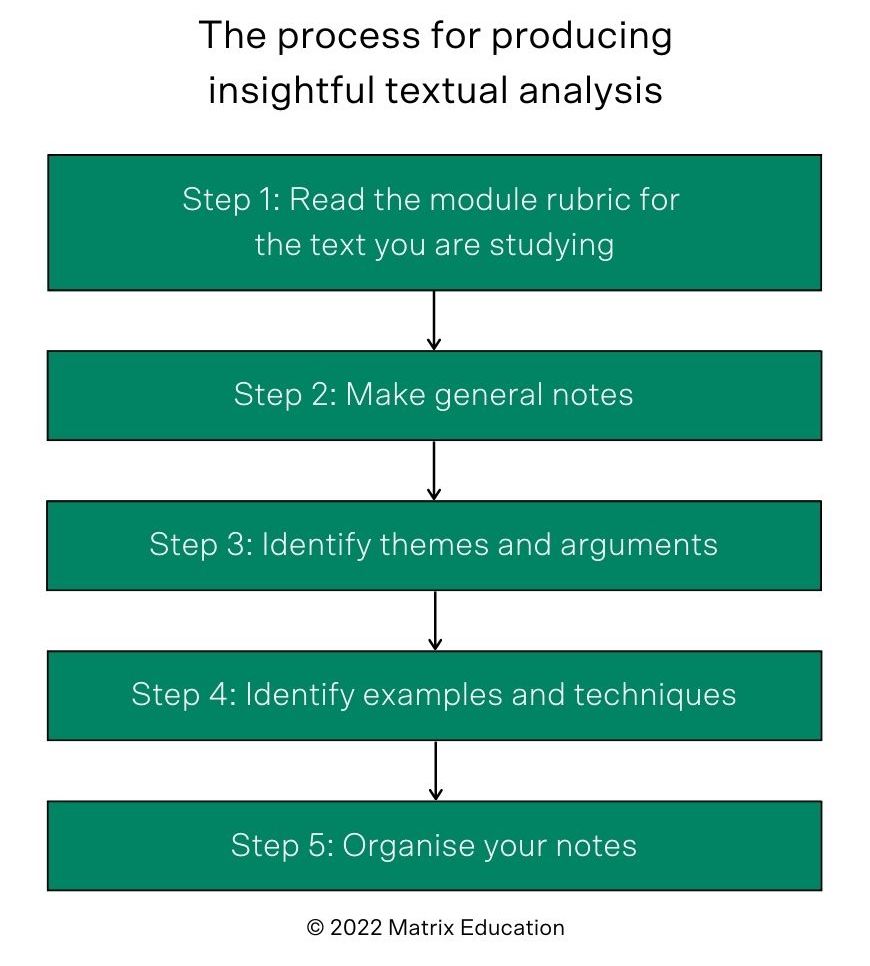
In this Part of our Beginner’s Guide to Acing HSC English, we will give you a thorough explanation of textual analysis and how to read your texts and walk you through a step-by-step process for creating flawless and insightful notes.
Download a free textual analysis planner to start writing sophisticated essays!
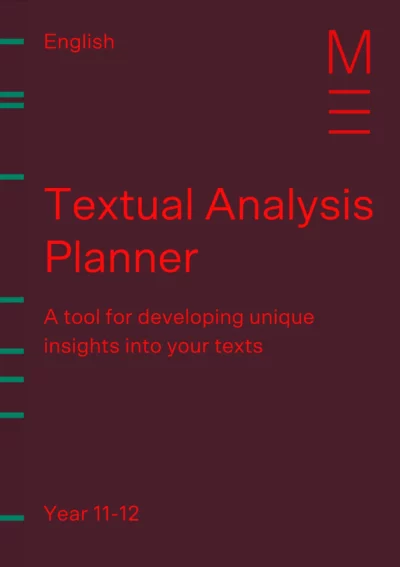
Level up how you analyse texts and take notes with expert strategies and templates!

Fill out your details below to get this resource emailed to you.
"*" indicates required fields
NESA provides syllabus rubrics for each English module. These rubrics explain what you will need to discuss in your textual analysis in order to get a Band 6. So, high-achieving students will read of the corresponding module rubric before they view the text they are studying. This allows them to direct their focus while they view their text and begin to think about how they can approach the module rubric statements.
You can find the full HSC module rubrics and quick breakdowns here:
When you view your text for the first time, there’s no need to desperately annotate every technique you see. Instead, just enjoy it and try to follow the plot.
Between viewings and at the end, jot down your thoughts about the following:
Later, you can use these notes to refresh your memory of the text and inspire your textual analysis.
Here’s an example of what that would look like:
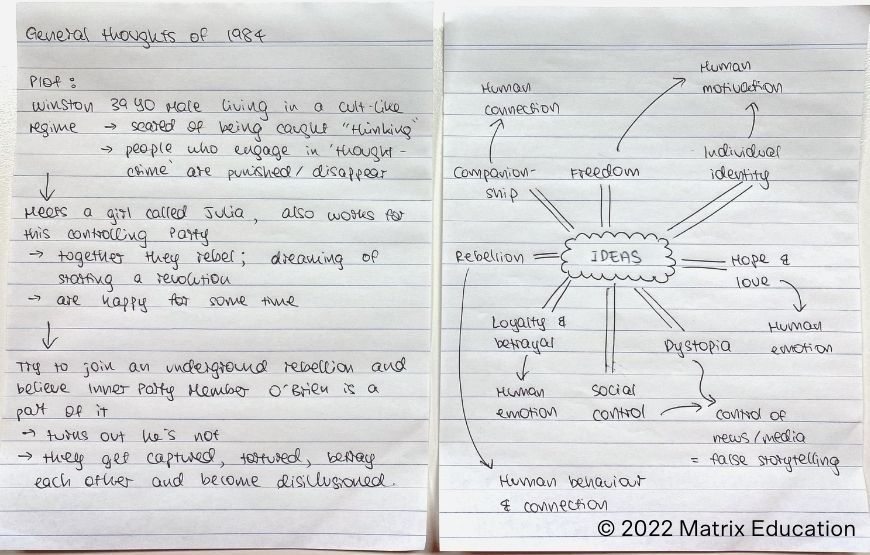
To help you make sense of the plot, themes and contexts of HSC English texts, we’ve created the cheatsheets for the following texts, as linked below.
You can find all our cheatsheets for English Standard, here.
At Matrix, we provide you with clear and structured lessons, quality resources, and personalised, constructive feedback from Matrix teachers.
Learn more about our Year 12 English Advanced Matrix Course now.
Start HSC English confidently
Expert teachers, detailed feedback, one-to-one help! Learn from home with Matrix+ Online English courses.
Often we refer to key ideas as themes because they are common to a number of texts, but also whole genres or selections of art and literature.
Knowing the genre of the text you are studying will give you hints as to what sort of themes you should look for. For example, a Gothic text will have themes of death, decay, and secrets. Even if you know roughly what themes will be in a text, you still need to identify them.
Here are some practical approaches you can take:
Ask yourself what the key ideas in the plot are. For example, is it about two people who are in love? Then love is a theme.
Do characters have trouble knowing if they are being told the truth or manipulated? The rift between appearance and reality is a theme.
The characters’ flaws are often the substance of the ideas the composer is trying to convey. We can look to a characters’ narrative arc to see what ideas are in a text.
For example, In Othello, the main characters are very proud and jealous. Pride and jealousy are key ideas in the play. We see these qualities reflected in the characteristics of other characters in the play, too.
In Nineteen Eighty-Four, the main character, Winston, and his lover, Julia rebel against the government. We can say resistance is a key idea in the text.
A recurring symbol, or motif, can embody a key idea in a text.
For example, In Black Swan, Nina’s character has to perform the roles of the Black and White Swan from Swan Lake. She has to be two opposing characters – pure and innocent and powerful and provocative – at the same time. We can say that dualism is a key theme in our textual analysis.


Sometimes composers are very direct with the ideas they feel are important in a text. They might discuss these ideas at length in the text – either directly or in the conversations that characters have. For example,
None of this has to be set in stone, as you will develop your arguments as you look over the evidence you’ll collect from the text. This is just to get you familiar with the talking about the text in light of the module rubric.
Here’s an example of themes and arguments you could make about Orwell’s Nineteen Eighty-Four for the HSC English Common Module.
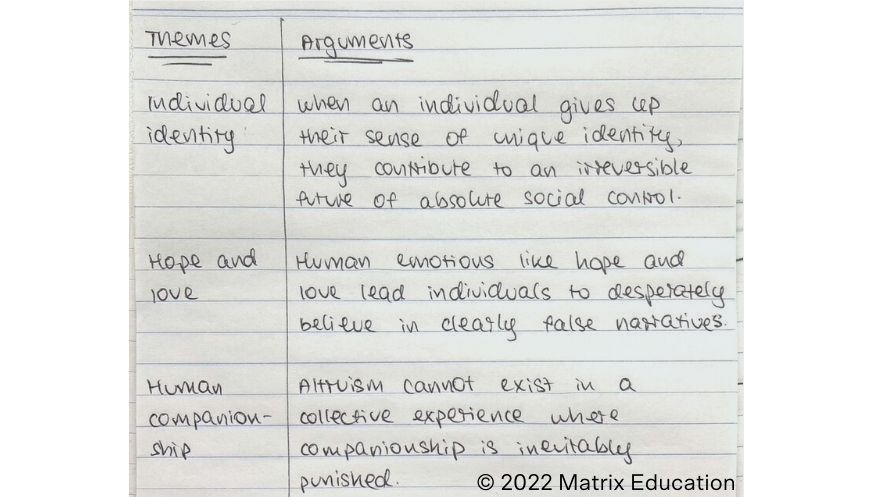
Essays for Stage 6 must be evidence-based. This means that students must provide examples from the text to support their arguments. They must then discuss how the techniques in those examples develop a certain meaning or reinforce a theme.
To be effective at identifying techniques, students must be aware of a wide range of techniques and their various applications. We’ve complied all the textual analysis techniques you need to know for various text types. You can access them through these links:
With this in mind, here’s how you can identify critical examples and their techniques.
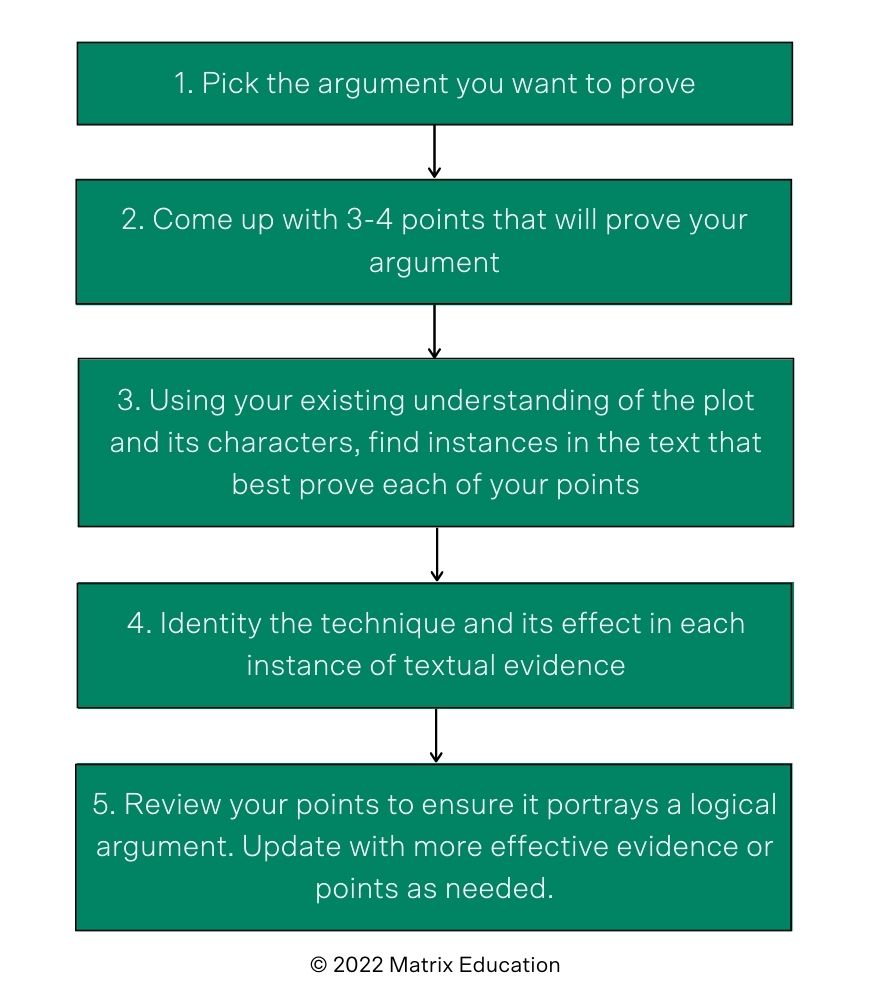
Making tables is the most efficient way to produce textual analysis notes for English. The principle behind making tables is to extract all of the relevant information from a text and place it in an easy to access document.
When you prepare for exams or write practice essays, you don’t want to be fishing through novels for quotations or skipping through films for the appropriate scene. Instead, you want to be able to find the example you need for your textual analysis as quickly and easily as possible. This is what tables are for.
Let’s look at an example of a study table:
| Theme/ Character | Evidence | Technique | Effect | Research | |
| What to do | Organise your textual analysis notes by theme or character | Provide a quotation or example from the text. | Note and describe the technique used. | Explain how the technique affects or shapes your understanding of the meaning in the example. | Look for what others say about this theme or example from the text? Try to look for scholarly articles. Wikipedia is a good place to begin research, but it is not always reliable or accurate. After reading a Wikipedia article, you should look at its sources and read those articles. Often, Wikipedia articles included suggested further reading, these are ideal places to further continue your research. We discuss Wikipedia and other research resources in Chapter 3 of this guide. Make note of your findings and keep track of the references. |
| Theme/ Character | Evidence | Technique | Effect | Research | |
| Othello | Iago’s villainy | Iago: And what’s he then that says I play the villain? / When this advice is free I give and honest (2.3. 330-331) | Rhetorical Question (hypophora – asks a question and immediately answers it). | Iago is giving them logical and helpful advice. The use of hypophora is a manipulative technique. Answering the question he’s asked immediately means that Iago’s listeners aren’t given time to formulate an answer against it. | 24th June: Not sure why Iago is evil? 26th June: Found a quote by R.Berry: “This is of the same order as the grotesquely exaggerated hell-imagery in his speeches, which we should not take at face-value. Iago, in truth, likes to think of himself as evil, as the villain: he plays the role in capital letters.” Berry argues that Iago revels in his villainy and his concealment of it. (R. Berry 1972. http://www.jstor.org/stable/2868648) |
© Matrix Education and www.matrix.edu.au, 2023. Unauthorised use and/or duplication of this material without express and written permission from this site’s author and/or owner is strictly prohibited. Excerpts and links may be used, provided that full and clear credit is given to Matrix Education and www.matrix.edu.au with appropriate and specific direction to the original content.